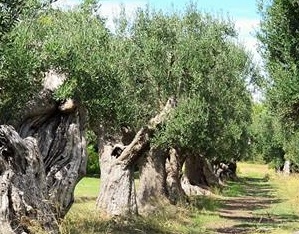Conceived to enhance the local area while promoting sustainable development at Crispiano, in the countryside near Taranto, this hundred-hectare vineyard/garden was recently planted with autochthonous vines to a design by landscape architect Fernando Caruncho.
The unique feature of this vineyard is how its espaliers are arranged, in a design of parallel undulating rows that run on for a number of kilometers, cadencing the contours of the land. In the designer’s words, like “the waves of time that have provided the rhythm to this place since days of yore”. You get to Amastuola along a long avenue flanked on both sides by centuries-old olive trees, planted so close to one another that they are perceived as a kind of serried parade, effectively forming a “plant wall” that, little by little, comes together and then breaks apart. Continuing up towards the farmhouse, the overview of the vineyard “wave” gradually opens up, seemingly in motion as you advance, to create a chiaroscuro effect: at times the olive trees take on the appearance of brushed velvet, especially when they are carressed by the wind and the slanting rays of the setting sun. The whole landscape was designed as if it were a garden. For Caruncho, landscape design is all about seeking a deep-seated order. Although space and time are two important parameters in his work, geometry is his mode of expression, his way of creating relations between architecture, landscape and sky. The vineyard has an irrigation system, but it is used only during particularly dry years; management software enables an agrometeorological station to provide a visualization of high-risk pest infection periods.
Highlights

"Waves"
Caruncho writes: “It was possible to perceive a certain musicality there, an all-enveloping melodic vibration. Time ceased to be linear, it became a spiral in which the past, present and future united in a single moment.” At Amastuola, these waves of time became the waves of this one-off agricultural garden.

Clumps of Olive Trees
The 1,500 centuries-old olive trees in the area were rearranged in clumps rather than the rows we’re more accustomed to seeing in the Apulian agricultural landscape. The contrast between the silvery-green olive tree foliage and the now intense bright green, now yellow and rust orange vine leaves, is a pleasant surprise.

Mobility
During design of the vineyard, the focus was on slow mobility, whether it be by bicycle, on foot or on horseback. The nearby Accetta Grande farm is both the point of departure and arrival.
 Masseria Amastuola
Contacts
Masseria Amastuola
Contacts
Contacts
Telephone:+39 099 990 80 25
Address
Località Amastuola, Strada Provinciale 42
74012, Crispiano (TA)
 Masseria Amastuola
Opening times and prices
Masseria Amastuola
Opening times and prices
Opening hours
The hours of the tour and wine tasting are as follows:
- From April to October: every day, in the afternoon at 5 pm by appointment.
For the opening times and opening hours of the other visitor routes, consult the
website
Pricing
Visit and wine tasting
- € 15,00 per person
Amastuola offers several tours that include a tour of the vineyard-garden, the farmhouse, the surrounding landscape and the opportunity to taste wines and local products. For information on costs and all the courses offered, consult the website
 Masseria Amastuola
How to get there
Masseria Amastuola
How to get there
Address
Località Amastuola, Strada Provinciale 42
74012, Crispiano (TA)
Latitude: 40.584688
Longitude: 17.186208
How to arrive by road
From A14 Autostrada Adriatica, enter SS7. At the roundabout take the second exit and continue on SP99. Then take SP40 and at the roundabout go straight on to Via Crispiano. Then at the roundabout take the second exit and continue on SP42.
 Masseria Amastuola
Services/Accessibility
Masseria Amastuola
Services/Accessibility
Services
Amastuola winery, with its rich production of wines, offers the possibility to buy its products in the online shop. online shop .
Amastuola offers its guests the opportunity to stay on the farm, in the Wine Resort, with exclusive rooms equipped with all comforts. For further information please consult the website
The Amastuola Restaurant offers its guests the opportunity to taste the traditional dishes of Puglia combined with a detailed selection of wines (red, white and rosé).
- is open every day for lunch and dinner.
- Private parties can also be organized by reservation.
The Amastuola Restaurant offers its guests the opportunity to taste the traditional dishes of Puglia combined with a detailed selection of wines (red, white and rosé).
- is open every day for lunch and dinner.
- Private parties can also be organized by reservation.
The Amastuola Restaurant offers its guests the opportunity to taste the traditional dishes of Puglia combined with a detailed selection of wines (red, white and rosé).
- is open every day for lunch and dinner.
- Private parties can also be organized by reservation.
The Amastuola Restaurant offers its guests the opportunity to taste the traditional dishes of Puglia combined with a detailed selection of wines (red, white and rosé).
- is open every day for lunch and dinner.
- Private parties can also be organized by reservation.
 Masseria Amastuola
Private events
Masseria Amastuola
Private events
Masseria Amastuola offers its spaces and its location for many private events such as meetings, conferences, business lunches and private parties.
 Masseria Amastuola
Itineraries
Masseria Amastuola
Itineraries
You could find the garden in these itineraries
 Favorite saving result
Favorite saving result
 Warning!
Warning!
You've have to sign up or sign in to add this element to your favorites.
